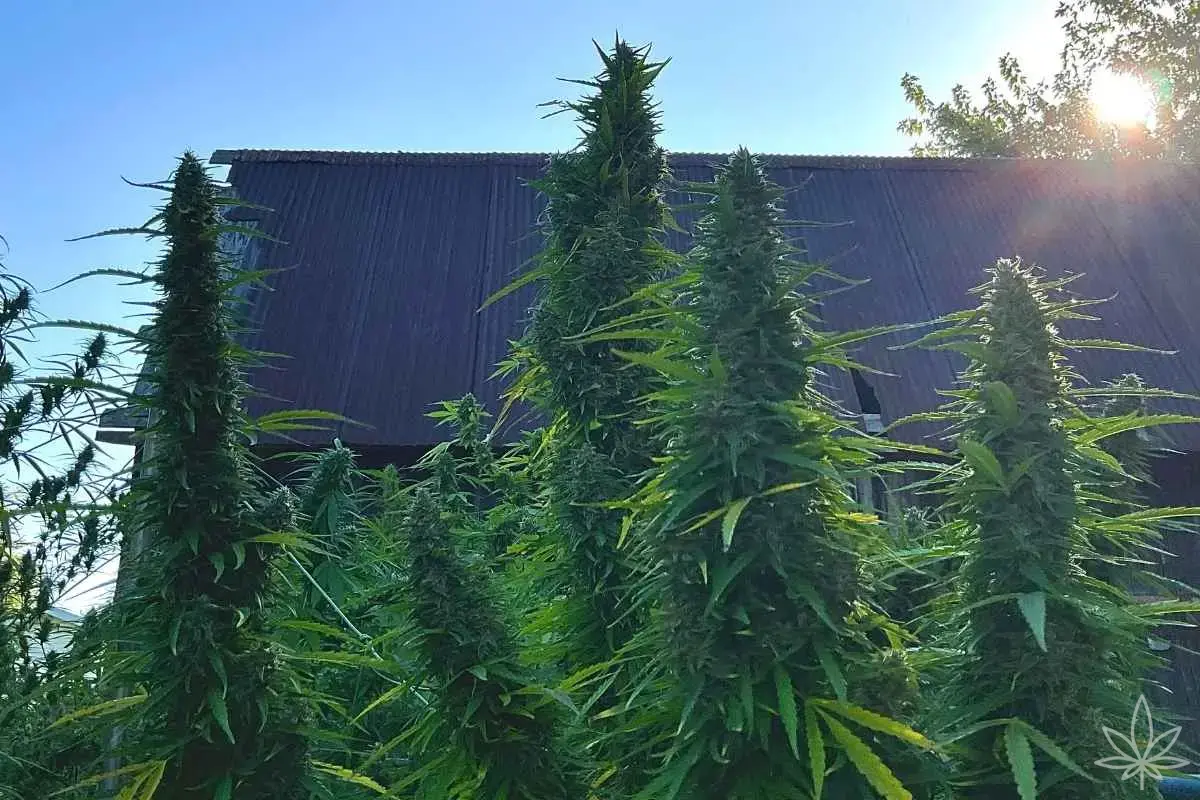Anyone who grows under open sky knows: nature makes no promises. One day the sun feeds the leaves like a postcard; by noon the next, a front rolls in and does the laundry on your whole garden. A week later comes a heatwave—air thick as honey, leaves curling into tubes. Just when you relax, the night brings an unexpected drop in temperature and a heavier-than-usual morning dew. This piece is about not getting caught off guard. More precisely, it’s about organizing your space and your work so you can respond quickly, calmly, and effectively.
It Starts With Place: Reading the Microclimate
No two plots are the same. Two meters to the right and you have a draft; three to the left there’s a pool of cold air. Before you drive the first stake, spend a week “reading” the site:
- The sun’s path. Does the garden wake slowly in the morning? Maybe there’s a wall of trees on the eastern edge. Write down the hours when sun actually hits the plants—this correction matters more than catalog promises of “full sun.”
- Air movement. A northerly gust, pockets of still air between the hedge and the shed—these are places where steam and spores linger after rain. Open them up and give plants some distance.
- Water and ground. Where does a puddle stand after a downpour, and where does soil drink like a sponge? Higher doesn’t always mean better, but a slight slope, raised beds, and mulch can change everything.
That site map is your first weather insurance policy.
Wind: Ally and Adversary
A little wind is free physiotherapy for stems and lowers disease pressure. Too much means snapped branches and stress. Balance is the art:
- Anchoring and training. Bamboo or steel stakes, or a cross-braced cord system—what matters is depth and cross-tying. As the plant grows, loosen and reposition ties rather than locking it into a rigid corset.
- Support netting. A low trellis (SCROG-style) at 30–50 cm acts like a hammock, distributing mass and reducing the “sail” effect in squalls.
- Natural windbreaks. Shrubs, corn, sunflowers—living barriers slow gusts without the turbulent backwash a solid panel can create.
Before a storm front, walk the rows: check knots, add a tie, remove loose items that will slap the plant in the wind.
Storms and Downpours: A Moment of Silence for Drainage
It’s rarely the water itself that does the lasting damage—it’s what follows: soil splashed onto leaves, compacted beds, slow drying. The fix is simple and always works:
- Mulching. A 5–8 cm layer (bark, wood chips, chopped straw, semi-mature compost, leaves) softens raindrop impact, keeps moisture in the soil rather than on the leaves, and limits erosion. Bonus: fewer weeds.
- Raised beds and “ridges.” On flat or heavy ground, a narrow bed lifted 15–20 cm above grade gives water somewhere to go. As a bonus, soil warms faster.
- Give water an exit. A shallow swale, cinder under a path, a permeable mat in choke points—small details that decide whether the garden breathes or wheezes after a storm.
After the storm: don’t step on beds while the soil is plastic. Let it breathe, then gently shake water from heavy branches, remove broken tissue, and—this matters—don’t feed immediately. Waterlogged roots need oxygen first, not a meal.
Heatwaves: The Garden on “Siesta”
Heat isn’t the problem by itself; it’s heat without water and without midday shade that hurts.
- Mulch (again). This is passive air conditioning. Beneath it evaporation slows, microbes work steadily, and root-zone temps drop a few degrees.
- Shade on demand. 30–40% shade cloth strung over light hoops or lines makes the difference between “barely coping” and “holding form.” Use it for the noon hours, not all day.
- Smart irrigation. Deep, less frequent watering (instead of frequent sips) teaches roots to reach down. Morning—before the sun bites—is prime time. Drip lines with a pressure reducer give consistency and save water.
- Environmental anti-stress. Ensure a breeze (not a draft). Avoid mechanical damage (hard pruning, aggressive tying) during peak heat—plants are already at the edge of their water budget.
If leaves taco at high noon but relax by evening, that’s a defense, not an emergency. The alarm triggers when the plant doesn’t recover overnight.
Cold Nights and Frost: Theater of a Single Degree
The margin is thin: 2–3 fewer degrees late at night and the season becomes a lottery. Therefore:
- Calendar and risk window. Set transplant dates by your local last/first frost statistics. Don’t rush. A strong plant a week later will outperform a chilled, stunted plant.
- Quick covers. Lightweight row cover, old sheets, mini-tunnels on hoops—these add a few crucial degrees at ground level. Put them on at dusk; remove at dawn so you don’t “cook” plants in the sun.
- Thermal mass. Barrels of water, stones, bricks—heat batteries that charge by day and release at night, smoothing the drop.
- Microtopography. Cold air drains to low spots. Sometimes moving plants three meters up to a slight ridge changes the whole night.
After a cold snap don’t comfort-feed. Give two–three days for recovery, then return to your routine.
Plant Architecture: Beating Gravity Before the Fight Starts
Outdoors, wind and rain decide the look of your training, not aesthetics. Aim for a shape that:
- Distributes mass across several strong leaders instead of one single pole.
- Creates skylights in the center—leaves should see the sky, not just each other.
- Lets you pull “to” and “from”—so branches flex with wind rather than lock and snap.
Gentle, regular adjustments (after rain, before a front, after a growth spurt) beat one big “surgery” a month.
Water Is Strategy, Not Just a Watering Can
Seasons of “short monsoons” and “long dry spells” teach humility. So:
- Harvest rain. A shed roof, a gutter, a 200-liter barrel—real help in heat. Rainwater is soft; plants like it.
- Teach soil to drink. Compost, rock dusts, biochar (charged) turn the profile into a sponge—holding moisture, releasing it slowly, stabilizing pH.
- Water by profile, not by calendar. Check moisture below the surface (finger/spade depth). Two identical forecast days don’t always mean two identical irrigations.
Post-Weather Hygiene: Small Service, Big Effect
Every weather event leaves traces: cracked tissue, mud on leaves, tiny wounds. Do a quick service:
- Clean cuts. Remove broken bits above a node with a sharp, disinfected tool.
- Leaves that can breathe. A gentle rinse the next sunny morning (not at night) washes off mud and spores; sun and breeze finish the drying.
- Space check. If anything hugs or rubs the plant (string, label, net), fix it now. Micro-injuries become pathogen gateways later.
Plan Like Logistics: Critical Path and Buffers
Sounds serious, but it’s really three simple rules:
- Time buffer. Assume at least one week will “fall out of the calendar” due to weather. Leave slack in your work and feeding schedule.
- Critical tasks. Some dates don’t move: transplanting to the final spot, tying down before a gale, frost covers, and prepping the drying space before late season begins.
- Plan B/C. Spare stakes, an extra roll of row cover, a pile of mulch, 20 meters of cord, and a handful of clips—cheap items that make a huge difference on the day the forecast “surprises” you.
The Gardener’s Psychology: Sober, No Flailing
The hardest part is often… doing nothing for a few hours. When the radar turns red, it’s easy to act nervously—replant, overhandle, dig wet soil. Sometimes the best move is to prepare, secure, then wait for the weather to pass. Gardens reward consistency, not panic.
Conclusion: Advantage Through Organization
Outdoor season is a negotiation with the elements. You won’t beat storms, heat, or cold by force, but you can win with organization: a conscious choice of place, smart mulch and drainage, flexible training, thoughtful shade and warmth at critical moments. Do these, and weather stops being an enemy and becomes a demanding partner. Instead of firefighting, you simply adjust the course.
At season’s end, when you look at a garden that sailed through downpours, scorchers, and chilly mornings without drama, you’ll know it wasn’t “luck with the weather.” It was logistics, patience, and a handful of small, steady decisions—day after day.







